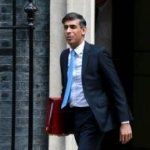British banks that took 2021’s bumper profits as a sign of better things to come will be bracing themselves for disappointment this week.
With the Covid pandemic waning, 2022 was meant to mark the slow return to normal: a rebound in international travel, economic growth, and interest rates up from record lows. Barclays’s former boss Jes Staley was particularly optimistic last year, saying that “tremendous pent-up demand” would lead to a robust economic recovery that would “carry through into 2022”.
But Russia’s invasion of Ukraine has rattled global markets and jeopardised energy supplies – exacerbating already-soaring costs for consumers and businesses and resulting in a dimmer outlook for bank earnings.
The UK’s cost-of-living crisis has arisen just months after the government ended Covid support schemes that not only kept companies and workers afloat but, by extension, helped banks avoid the surge in defaults that was feared at the start of the pandemic.
But the broader effects of rising inflation and geopolitical tension are being felt worldwide, with JP Morgan’s boss, Jamie Dimon, warning last week that a recession was “absolutely” possible.
It means the same banks that released billions of pounds’ worth of loan loss provisions last year, in the belief that the worst was over, will have to start clawing back that cash as borrowers fall on hard times. That will dampen earnings growth and forecasts at the UK’s big four lenders – Lloyds, NatWest, HSBC and Barclays – all of which are due to report first-quarter results over the coming week.
For example, Barclays is expected to put aside £299m for potential defaults, up from £55m a year earlier, when Staley was predicting an economic boom. That is likely to contribute to a potential 45% slump in profits to £1.3bn, according to average analyst estimates.
Similarly, HSBC is likely to put aside $934m (£715m) to protect itself against potential defaults in the first quarter, compared with the $435m it released at the start of 2021. That will play a part in slashing HSBC’s pre-tax profits by more than a third to $3.7bn, according to consensus estimates.
Profits at Barclays and HSBC will also be affected by the end of the investment banking boom, as fewer companies raise money on the financial markets and hold back from mergers and takeovers. The ripple effects of Russia’s invasion of Ukraine have generally made firms more cautious about launching deals or fundraising.
British banks’ Wall Street counterparts have already felt the blow, with first-quarter profits nearly halving at JP Morgan, Goldman Sachs, Morgan Stanley and Citi.
But the UK’s domestically focused lenders – including Lloyds and NatWest – will also feel the pinch. With customers more likely to default, banks have been tightening their lending criteria, meaning lower income from otherwise lucrative loans. Particular attention will be paid to the outlook for mortgages, after it emerged this month that banks were starting to take the cost-of-living crisis – including higher energy and grocery bills as well as the national insurance rise – into consideration when calculating how much to offer borrowers.
Meanwhile, banks that have benefited from surging UK house prices, which increased demand for larger home loans, will be aware that the cost-of-living crisis is also likely to dampen house price growth over the coming year.
That will hurt domestic lenders such as Lloyds, which owns Halifax– the country’s largest mortgage lender, considered a bellwether for the UK economy. Analyst forecasts published this month suggest pre-tax profits at Lloyds could fall by 25% to £1.4bn, while NatWest is estimated to see its own profits drop 20% to £755m.
Read more:
Bank bosses’ optimism darkens as war follows on the heels of Covid






